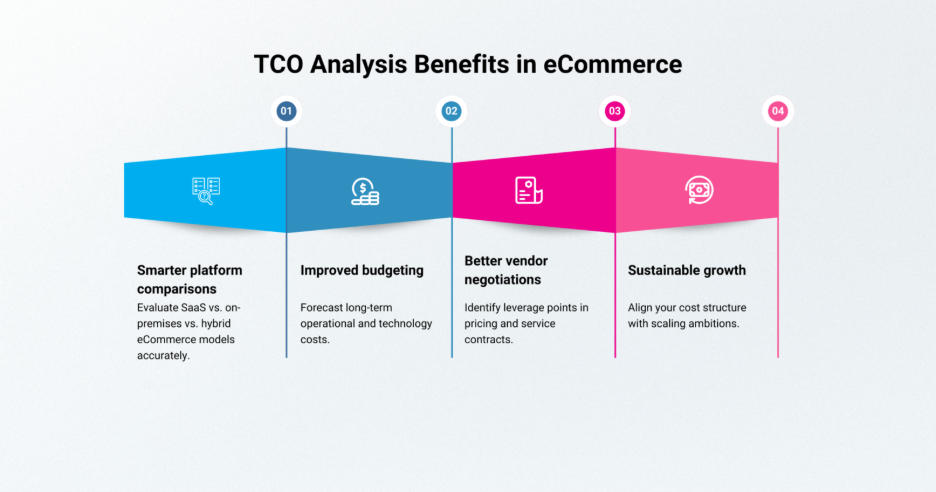In today’s fast-paced digital economy, eCommerce businesses face increasing pressure to balance growth with profitability. Understanding the Total Cost of Ownership (TCO) for eCommerce platforms is critical for making informed investment decisions that extend beyond subscription or setup fees.
A detailed TCO analysis for eCommerce reveals both the visible and hidden expenses that influence operational efficiency and long-term profitability. Whether you're evaluating Shopify Plus, BigCommerce, or a custom SaaS solution, knowing your eCommerce cost breakdown can uncover substantial savings and guide smarter platform choices.
TCO analysis in eCommerce is a comprehensive evaluation of all costs associated with owning, operating, and maintaining your online platform over time. Unlike simple cost comparisons, it factors in both direct expenses, such as licensing, hosting, and transaction fees, and indirect costs like maintenance, integrations, upgrades, and customer support.
This holistic view enables eCommerce decision-makers to assess not just the initial price tag but the true long-term investment required to keep their operations competitive and scalable.

Understanding TCO is essential for strategic financial planning. A complete eCommerce cost breakdown ensures that decision-makers grasp both short-term and long-term financial commitments.
The eCommerce cost breakdown is the backbone of TCO analysis. It divides expenses into direct and indirect categories, giving a clear sense of where resources are spent—and where optimization is possible.
Direct costs are immediate and easy to quantify:
Indirect costs often go unnoticed until they erode margins:
Selecting the right eCommerce platform requires evaluating total ownership costs over multiple years, not just upfront pricing. Each model, SaaS, on-premises, or hybrid has unique implications for TCO.
SaaS platforms such as Shopify Plus or BigCommerce offer predictable monthly fees and minimal maintenance overhead. Updates and security are handled by the provider, reducing internal IT costs.
On-premises solutions, like Magento (Adobe Commerce) or custom builds, provide full control but come with higher infrastructure, staffing, and maintenance expenses. Businesses must handle updates, security patches, and hosting.
Hybrid models blend both approaches, offering flexibility and scalability but requiring careful forecasting to avoid unexpected expenses.
When conducting your TCO analysis for eCommerce platforms, include both short-term implementation costs and long-term maintenance projections to make a true apples-to-apples comparison.
A structured approach ensures accuracy and consistency. Here’s a proven framework for analyzing your eCommerce TCO:
A disciplined TCO analysis process helps ensure accurate forecasting and better decision-making.
A transparent view of total ownership costs empowers leaders to make data-driven improvements. Effective TCO eCommerce analysis can identify opportunities to:
For retailers expanding into omnichannel, this visibility supports cost-efficient scaling while maintaining customer experience excellence.
Integrating TCO analysis into your eCommerce strategy provides the clarity needed to optimize platforms, streamline operations, and drive sustainable profitability.
A disciplined, data-backed approach helps uncover the true costs behind every click, conversion, and integration, ensuring your eCommerce investments create measurable long-term value.
Explore how Tidal Commerce can help your business maximize ROI and reduce operational costs. Schedule your free TCO consultation
Get monthly insights, case studies, and bold ideas from the front line of digital commerce & CX.